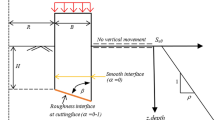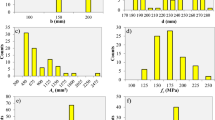Abstract
In this study, the effect of high temperature on the flexural and compressive strength of mortars containing waste PET aggregates was investigated experimentally. The mortar samples prepared in 5 different concentrations with a total of 2.5%, 5%, 10%, 20% and 30% PET aggregate substitution were heated up to 100, 150, 200, 250, 300 and 400 °C. After waiting for 1, 2 and 3 h at these temperatures, flexural and compressive strength tests were performed. It was observed that flexural strength and compressive strength values decreased with increasing temperature and PET aggregate amounts in all mixtures. An artificial neural network was designed to estimate flexural and compressive strength values using experimental data. It has been observed that the developed artificial neural network can predict flexural and compressive strengths with an average error of − 0.51%.





















Similar content being viewed by others
Abbreviations
- ANN:
-
Artificial neural network
- HDPE:
-
High density polyethylene
- HSC:
-
High-strength concrete
- MSE:
-
Mean square error
- PET:
-
Polyethylene terephthalate
- PVC:
-
Polyvinyl chloride
- RSM:
-
Response surface methodology
- A c :
-
Cross-sectional area (mm2)
- b :
-
Narrow edge length of the sample section (mm)
- d :
-
Height of the sample section (mm)
- f c :
-
Compressive strength
- L :
-
The distance between the support rollers (mm)
- P :
-
Applied force (N)
- t :
-
Time (h)
- T :
-
Temperature (°C)
- σ :
-
Flexural strength (MPa)
References
Akçaözoğlu, S.; Akçaözoğlu, K.; Atiş, C.D.: Thermal conductivity, compressive strength and ultrasonic wave velocity of cementitious composite containing waste PET lightweight aggregate (WPLA). Compos. Part B 45, 721–726 (2013)
Akçaözoğlu, S.; Atiş, C.D.: Effect of granulated blast furnace slag and fly ash addition on the strength properties of lightweight mortars containing waste PET aggregates. Constr. Build. Mater. 25, 4052–4058 (2011)
Akçaözoğlu, S.; Atiş, C.D.; Akçaözoğlu, K.: An investigation on the use of shredded waste PET bottles as aggregate in lightweight concrete. Waste Manag 30, 285–290 (2010)
Küçükaltun, E.; Evliya, H.: Increasing hydrolysis resistance of polyethylene terephthalate. Çukurova Univ. J. Sci. Eng. Sci., 27-4 (2012)
Akçaözoğlu, S.: Usability of Waste Pet Bottle Fractures as Lightweight Concrete Aggregate. Ph.D. Thesis, Çukurova University, Institute of Science, Adana, pp. 4–9 (2008)
Mohammadıahmadabad, Y.: A Research on Determining the Properties of Concrete Produced with Ground Waste Pets. Master Thesis, Atatürk Üniversity Institute of Science, Erzurum, pp. 2–3 (2014)
Gönen, T.; Onat, O.; Cemalgil, S.; Yılmazer, B.; Altuncu, Y.T.: An investigation on new waste materials for concrete technology. Electron. J. Build. Technol. 8(1), 36–43 (2012)
Demir, A.: Investigation of the Effect of High Temperature in Tile Broken Aggregate Concretes. Ph.D. Thesis, Eskişehir Osmangazi University Fen Bilimleri Enstitüsü, Eskişehir, pp. 15–16 (2008)
Nematzadeh, M.; Shahmansouri, A.A.; Fakoor, M.: Post-fire compressive strength of recycled PET aggregate concrete reinforced with steel fibers: optimization and prediction via RSM and GEP. Constr. Build. Mater. 252, 119057 (2020)
ACI 216.1-07/TMS-0216-07: Code requirements for determining fire resistance of concrete and masonry construction assemblies. In: ACI Committee 216 (ed.) ACI Manual of Concrete Practice, Part 1, American Concrete Institute, Farmington Hills, Michigan (2007)
EN 1994-1-2: Eurocode 4: Design of Composite Steel and Concrete Structures, Part 1–2: General Rules—Structural Fire Design. BSI British Standards, Brussels (2005)
Alfahdawi, I.H.; Osman, S.A.; Hamid, R.; AL-Hadithi, A.I.: Influence of PET wastes on the environment and high strength concrete properties exposed to high temperatures. Constr. Build. Mater. 225, 358–370 (2019)
Mohammed, A.A.; Rahim, A.A.F.: Experimental behavior and analysis of high strength concrete beams reinforced with PET waste fiber. Constr. Build. Mater. 244, 118350 (2020)
Reis, J.M.L.; Carneiro, E.P.: Evaluation of PET waste aggregates in polymer mortars. Constr. Build. Mater. 27, 107–111 (2012)
Hammoudi, A.; Moussaceb, K.; Belebchouche, C.; Dahmoune, F.: Comparison of artificial neural network (ANN) and response surface methodology (RSM) prediction in compressive strength of recycled concrete aggregates. Constr. Build. Mater. 209, 425–436 (2019)
Sarıdemir, M.: Predicting the compressive strength of mortars containing metakaolin by artificial neural networks and fuzzy logic. Adv. Eng. Softw. 40, 920–927 (2009)
Lan, G.; Wang, Y.; Zeng, G.; Zhang, J.: Compressive strength of earth block masonry: estimation based on neural networks and adaptive network-based fuzzy inference system. Compos. Struct. 235, 111731 (2020)
Onal, O.; Ozturk, A.U.: Artificial neural network application on microstructure–compressive strength relationship of cement mortar. Adv. Eng. Softw. 41, 165–169 (2010)
Onyari, E.K.; Ikotun, B.D.: Prediction of compressive and flexural strengths of a modified zeolite additive mortar using artificial neural network. Constr. Build. Mater. 187, 1232–1241 (2018)
Albano, C.; Camacho, N.; Hernández, M.; Matheus, A.; Gutiérrez, A.: Influence of content and particle size of waste pet bottles on concrete behavior at different w/c ratios. Waste Manag 29, 2707–2716 (2009)
Rahmani, E.; Dehestani, M.; Beygi, M.H.A.; Allahyari, H.; Nikbin, I.M.: On the mechanical properties of concrete containing waste PET particles. Constr. Build. Mater. 47, 1302–1308 (2013)
TS EN 197-1, Cement—Part 1: Composition, Specification and Conformity Criteria for Common Cements. Turkish Standards Institution (2012)
TS EN 1097-6, Tests for Mechanical and Physical Properties of Aggregates—Part 6: Determination of Particle Density and Water Absorption. Turkish Standards Institution (2013)
TS EN 934-2 + A1, Admixtures for Concrete, Mortar and Grout—Part 2: Concrete Admixtures—Definitions, Requirements, Conformity, Marking and Labelling. Turkish Standards Institution (2013)
TS EN 196-1, Methods of Testing Cement—Part 1: Determination of Strength. Turkish Standards Institution (2016)
Gao, W.; Dimitrov, D.; Abdo, H.: Tight independent set neighborhood union condition for fractional critical deleted graphs and ID deleted graphs. Discrete Contin. Dyn. Syst. Ser. 12, 711–721 (2019)
Gao, W.; Wu, H.; Siddiqui, M.K.; Baig, A.Q.: Study of biological networks using graph theory. Saudi J. Biol. Sci. 25, 1212–1219 (2018)
Gao, W.; Wang, W.; Dimitrov, D.; Wang, Y.: Nano properties analysis via fourth multiplicative ABC indicator calculating. Arab. J. Chem. 11, 793–801 (2018)
Gao, W.; Guirao, J.L.G.; Abdel-Aty, M.; Xi, W.: An independent set degree condition for fractional critical deleted graphs. Discrete Contin. Dyn. Syst. Ser. 12, 877–886 (2019)
Gao, W.; Guirao, J.L.G.; Basavanagoud, B.; Wu, J.: Partial multi-dividing ontology learning algorithm. Inf. Sci. 467, 35–58 (2018)
Bahiraei, M.; Heshmatian, S.; Moayedi, H.: Artificial intelligence in the field of nanofluids: a review on applications and potential future directions. Powder Technol. 353, 276–301 (2019)
Feng, Q.; Zhang, J.; Zhang, X.; Wen, S.: Proximate analysis based prediction of gross calorific value of coals: a comparison of support vector machine, alternating conditional expectation and artificial neural network. Fuel Process. Technol. 129, 120–129 (2015)
Çolak, A.B.: An experimental study on the comparative analysis of the effect of the number of data on the error rates of artificial neural networks. Int. J. Energy Res. (2020). https://doi.org/10.1002/er.5680
Çolak, A.B.; Yıldız, O.; Bayrak, M.; Tezekici, B.S.: Experimental study for predicting the specific heat of water based Cu-Al2O3 hybrid nanofluid using artificial neural network and proposing new correlation. Int. J. Energy Res. 44, 7198–7215 (2020)
Vaferi, B.; Samimi, F.; Pakgohar, E.; Mowla, D.: Artificial neural network approach for prediction of thermal behavior of nanofluids flowing through circular tubes. Powder Technol. 267, 1–10 (2014)
Vaferi, B.; Eslamloueyan, R.; Ayatollahi, S.: Automatic recognition of oil reservoir models from well testing data by using multi-layer perceptron networks. J. Pet. Sci. Eng. 77, 254–262 (2011)
Author information
Authors and Affiliations
Corresponding author
Rights and permissions
About this article
Cite this article
Çolak, A.B., Akçaözoğlu, K., Akçaözoğlu, S. et al. Artificial Intelligence Approach in Predicting the Effect of Elevated Temperature on the Mechanical Properties of PET Aggregate Mortars: An Experimental Study. Arab J Sci Eng 46, 4867–4881 (2021). https://doi.org/10.1007/s13369-020-05280-1
Received:
Accepted:
Published:
Issue Date:
DOI: https://doi.org/10.1007/s13369-020-05280-1




